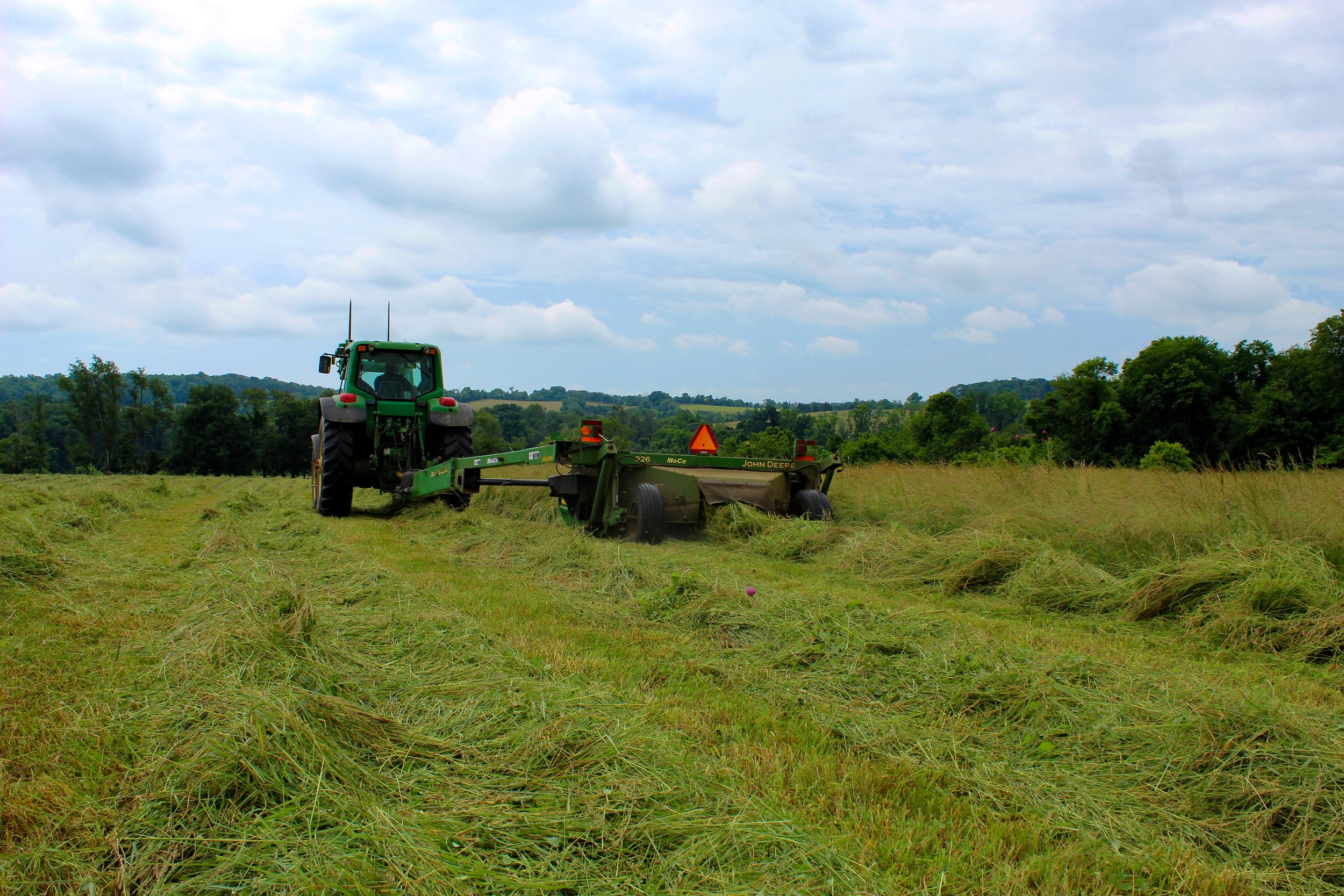The art of organic hay production
At Ayrshire Farm, making hay is not just a means of food, but a way of life
Ayrshire Farm’s Ismael Cortes Arellano mows one of the farm’s hay fields in early June.
This is the third installment in the WholeHarvest Year series, which aims to chronicle the farming cycle at Ayrshire Farm.
Late spring means one thing for the crew at Ayrshire Farm: Hay-making season.
The process of cutting, baling, and hauling organic hay from 650 acres typically lasts 4 to 6 weeks. It’s a big undertaking, but one that’s vital for providing year-round nutrition to the farm’s heritage-breed animals.
Ayrshire Farm and the livestock it raises are both USDA Certified Organic. And that means the animals here can only eat organic food. So, whether that food is grass and forages from the farm’s pastures – their number one food source – or supplemental hay, it all must be organic to meet the certification requirements. Labeling hay as organic requires using a longer crop rotation than regular counterparts, not adding pesticides or synthetic chemicals to the soil when harvesting, fertilizing only with manure, and using naturally mined minerals to improve overall soil health.
At other farms, adhering to organic standards might be a burden. But at Ayrshire, it blends harmoniously with the farm’s regenerative practices: strengthening the health and vitality of the soil, increasing biodiversity, improving water use, and optimizing resources.
The meticulous art of producing organic hay stands as a testament to regenerative farming, nurturing both the soil and the animals that graze upon its bounty.
Good For Animals, Good For the Earth
On a warm June day, Chris Damewood, farm manager at Ayrshire Farm, is inspecting the progress at one of the farm’s hay fields. He points out a few of the species that have been cut and are now drying in tidy rows. Clover, timothy grass, orchard grass.
“When we first started here, this field didn’t have clover and was very low producing,” Damewood says. “Now we’re producing one and a half tons of dried hay per acre.”
At that rate, Ayrshire is harvesting about nine bales every two acres, with each bale clocking in around 650 pounds.
The livestock at Ayrshire Farm are raised 100% on pasture, which ensures they get the space and nutrition they need to thrive. Pasture is king, but high-quality organic hay is also crucial for the animals’ health and well-being. Hay provides nutrients that promote salivation, digestion, and nutrient absorption. It’s fed to the farm’s 460 cattle and 17 Shire draught horses as needed, serving up essential dry matter and protein, especially in the winter when prime forages are more scarce.
The natural growth process and absence of synthetic additives ensures that organic hay contains a higher nutritional value than its non-organic counterpart, which directly benefits animals’ health and productivity. Ayrshire’s hay is tested regularly for markers like protein, digestibility, and minerals to ensure livestock get only the best.
Any bales that fall short of perfection are used as bedding for pigs and young calves in winter, or other animals that need to be kept in barns.
Growing hay organically and regeneratively also comes with environmental benefits. Compared to conventional methods, organic pasture farming practices tend to emit less carbon dioxide and other harmful gases compared to conventional farming methods. It can also lead to a significant reduction in nitrous oxide emissions and an increase in methane uptake, leading to enhanced soil, air, and water quality.
Staying Adaptable
This year has been a challenging one for haying in northern Virginia. An unusually rainy start to spring meant pushing back the harvest, and then, continually dodging showers once work got underway.
Wet weather hinders the field-curing process, making it challenging to maintain below 16% moisture consistently. Too moist, and you run the risk of mold and combustion. Too hot, on the other hand, and you have to contended with longer recovery times between cuttings, nutrient loss in the final product, and poor digestibility.
The haying process begins with mowing, ideally on a dry day. After mowing, the hay is tedded to spread and aerate it. Wide swaths are laid to ensure maximum exposure to sunlight — essential for reducing moisture content from about 75-80% in freshly cut forage down to the optimal 14-18% for baling.
Once the hay reaches the appropriate moisture level, it’s raked into windrows and then baled. After baling, it is critical to store the hay properly to maintain its quality.
It’s long work and probably not many folks’ idea of a good time: ticks, heat, sharp hay piercing every sliver of exposed skin. And this is just the first pass – there will be another cutting again in the fall.
But Damewood feels confident the farm won’t have to buy any hay this year, and that’s a good feeling. It means organic and regenerative farming is working, and it proves that being good stewards of the land reaps numerous benefits — now, this winter, and in the years to come.












